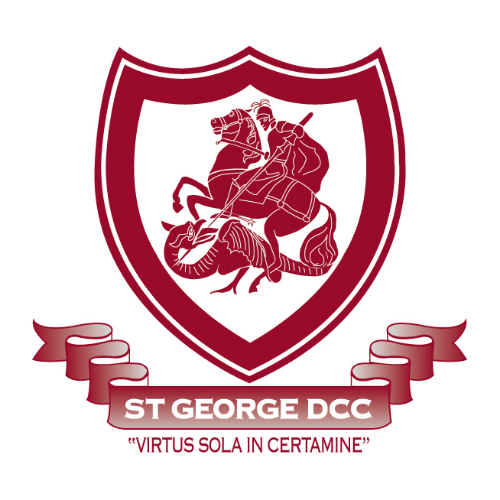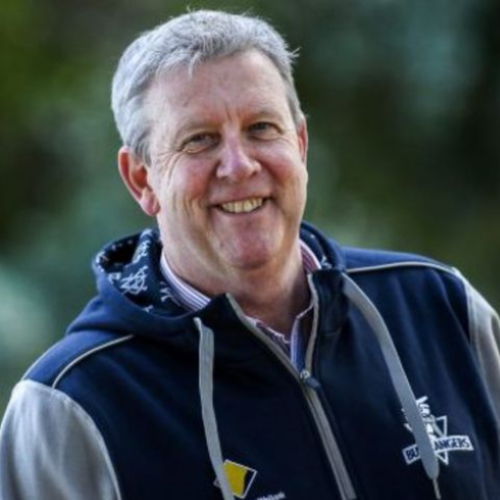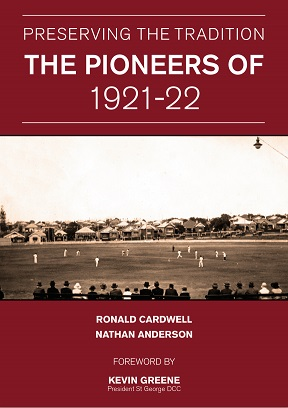Nathan Anderson is one of those cricketers that gives everything on the field and even more off it. As the grandson of one of the greats of St George cricket, Brian Booth, Nathan is making his own unique mark at St George with the release of a book co-authored with cricket historian Ronald Cardwell. Find out more on the writing of this book as we dig a little deeper with the man himself, Nathan Anderson.
How was the concept for the book conceived?
I believe it was club President Kevin Greene who raised the idea of a book on the legacy of the initial First Grade team to play for St George 100 years ago in 1921-22. Kevin approached Ronald Cardwell, who had helped Mike Coward with the St George Centenary book in 2010, to undertake the writing process. At some point after that, Ronald approached me and asked if I would like to be involved.
What were your thoughts when you were asked to be a part of this project?
Initially I was quite surprised. I had never written a book before, but I had done some work with Ronald and for the club in 2018 for a University subject which involved tabulating the various items in the Booth Saunders Pavilion at Hurstville Oval. I jumped at the opportunity though, it sounded like a really interesting and exciting project to be a part of.
Tell us a little more about your own background -
I’ve been playing cricket since I was about 6 years old and I’ve loved it ever since. I started off with Panania East Hills RSL Cricket Club, where the Waugh brothers played, for 10 years and also played all of my junior rep cricket with Bankstown. I first played for St George in the A.W. Green Shield competition and have played all of my Grade Cricket there. Outside of cricket, I am in my final year of a Bachelor of Education/Bachelor of Arts Double Degree at Sydney University majoring in history. I’ve always had an interest in history, which was more than likely stoked by both of my Grandfathers’ having experienced much in their own lifetimes and myself being fascinated by their stories.
Tell us about the initial planning of the book -
In 2019 I received a phone call from Ronald, who asked me to co-write the book with him. Following that, we met up on a number of occasions to discuss a rough outline for the book and where we should start off with research. We found that there were 19 men that represented the club in first grade in the 1921-22 season and we split up the researching duties in an attempt to find out a bit more on each player. On top of the biographies of each player, we decided that it would be interesting to write about the St George region at the time, as well as provide a summary of how the team went during the season.
How does one go about researching and obtaining information on cricketers from 100 years ago?
There are actually quite a few different sources of information that were useful to us. Trove is a website run by the National Library of Australia which has thousands of digitised newspaper articles from the 1800s all the way through to the mid-twentieth century. The St George Call, The Propeller, The Referee and The Arrow were some of the more prominent newspapers from the time from which we were able to ascertain information. The 1921-22 season was only a few years after the First World War so it was reasonable to suspect that some of the players involved may have served in the conflict. The Australian War Memorial records were quite useful to gain information such as service records on some of the players. The NSW Births, Deaths and Marriages website was also well frequented by Ronald and myself. This website helped us to narrow down individuals and to ensure that we had information on the right people.
There was some useful information in the St George DCC and NSWCA Annual Reports, but mostly within the context of player statistics and some standout performances. Ronald was able to contact a number of surviving family members, who gave some very valuable information which we were able to use in the book. They could add in some information that we didn’t have, or they provided photo’s which were used in the book.
Did you ever initially think that this task was too grand for yourself given you had never written a book before?
No, not really. I was quite fortunate to be working with Ronald, who has quite a strong background in research and writing. He gave me lots of helpful tips and some very useful advice as we continued to work through it. Due to my passion for history and cricket, it never really felt like a chore to be working on the book. It was good fun all the way through because there were so many interesting stories that we uncovered as we kept going. From start to finish how long did the process take? We began the planning process in early 2019 and the book was launched in February of this year, so it would be around 18-24 months. The bulk of the writing was done in the last 12-18 months though. The lockdowns in 2020 actually gave me quite a lot of time to research and write for the book.
How many of the 19 individuals did you get to write about and was there a definite favourite?
Ronald and I both covered seven each and then we worked together on the other five, who were a bit more difficult to track down. Quite remarkably, all 19 men lived fascinating lives. They often varied in what they did for work, but none of that mattered when it came to playing cricket. Having said that, there were a few who I really enjoyed researching:Horace Harper was the first player I researched and he led quite an interesting life. He served in WWI and captained the St George Second Grade side and yet they were probably the less interesting aspects of his life. Following cricket he entered politics and went head to head with the infamous NSW Labor Premier Jack Lang, who had recently been dismissed from office. He was a Grandmaster of the Independent Order of Odd Fellows for a number of years which saw him travel across the world, he was then the General Manager of the Griffith Cannery before coming back to the St George area to open a newsagent with his son. He lived quite a storied life.Another interesting fellow was Lyall Wall, a boilermaker from Balmain who represented New South Wales in both Rugby League and cricket. He won four NSWRL premierships with Balmain in the 1910s and has the special distinction of representing St George in their first seasons of First Grade cricket and First Grade Rugby League in 1921, the only person to do so. He was quite the journeyman though. He played League for Balmain, Annandale, Western Suburbs and St George and took the cricket field for Balmain, Western Suburbs, St George, Sydney, Paddington and Waverley. He took 651 First Grade wickets at 17.38.
For the other Seventeen, you’ll have to read the book!
To purchase your very own copy of the book visit our online store
Join the cricket network to promote your business and expertise. Make it easy for people to search and find the people and services they need through people they know and trust.
Join the network








